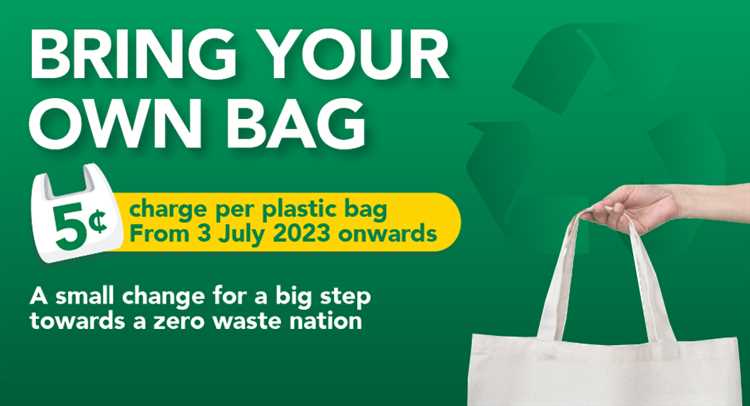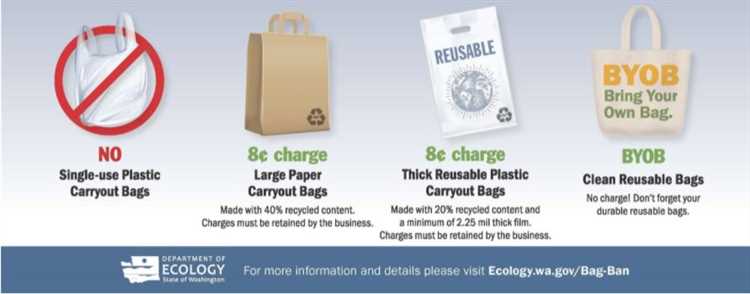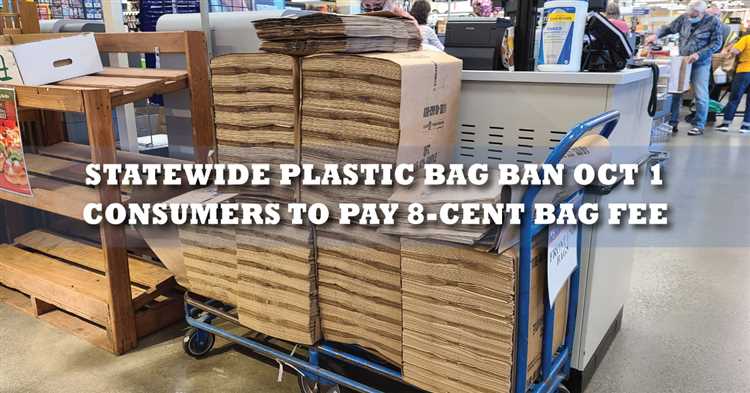In recent years, many countries and cities around the world have implemented a bag charge in an effort to reduce plastic waste and promote reusable alternatives. One such charge is the 8 cent bag charge, which has become increasingly common in various regions. But have you ever wondered where that 8 cents actually goes?
Contrary to popular belief, the purpose of the bag charge is not just to generate revenue for the government or businesses. Instead, the main goal is to encourage individuals to bring their own reusable bags when shopping, in order to reduce the environmental impact of single-use plastic bags. The 8 cent charge serves as a deterrent, making people think twice before requesting a plastic bag.
So, what does happen with the 8 cent bag charge? Well, it depends on the specific region and its regulations. In many cases, the money is used for various environmental initiatives, such as funding recycling programs, supporting sustainable projects, or even investing in education and awareness campaigns about the importance of reducing plastic waste.
It’s important to note that the bag charge is not meant to be a punishment, but rather an incentive to change behavior and promote more eco-friendly habits. By putting a small fee on plastic bags, governments and local authorities aim to encourage individuals to think more about the impact of their consumption choices and opt for reusable bags as a more sustainable alternative.
So next time you’re charged 8 cents for a plastic bag at the store, remember that this small fee is playing a part in creating a cleaner and greener future for our planet.
- Where does the 8 cent bag charge go?
- Environmental initiatives
- Government funds
- Retailer responsibility
- Understanding the bag charge system
- The impact of the bag charge system
- The impact on the environment
- Supporting local communities
- The role of retailers
- Reporting and remittance
- Enforcement and penalties
- Question-answer:
- What is the purpose of the 8 cent bag charge?
- How is the 8 cent bag charge implemented?
- What happens to the money collected from the bag charge?
- Are there any exemptions to the 8 cent bag charge?
Where does the 8 cent bag charge go?
The 8 cent bag charge is a fee that is imposed on customers for each single-use plastic bag they receive when shopping. This charge aims to reduce the use of plastic bags and encourage the use of reusable bags, in order to minimize plastic waste and protect the environment.
Environmental initiatives

The revenue generated from the bag charge is often used to fund various environmental initiatives. These initiatives can include recycling programs, waste management projects, and educational campaigns that promote sustainable practices.
Government funds

In some cases, the bag charge revenue goes directly to the government. This money can be used to support various public services and infrastructure improvements. It can help fund initiatives related to environmental protection or be allocated to other areas of public interest.
Retailer responsibility

In certain regions, retailers are responsible for collecting the bag charge and ensuring that it is properly handled. They may have agreements with local authorities or environmental organizations to contribute a portion of the revenue to specific environmental programs or projects.
It’s important to note that the destination of the 8 cent bag charge can vary depending on the specific regulations and policies in place. Local laws may dictate how the revenue should be allocated and spent. The ultimate goal of this charge is to create a cleaner and more sustainable environment by reducing the consumption of single-use plastic bags.
Understanding the bag charge system
Many countries and cities have implemented bag charge systems as a way to reduce plastic waste and promote sustainability. The 8 cent bag charge is a small fee that customers pay when they use plastic bags at the checkout counter. But where does this money go?
The 8 cent bag charge is typically collected by retailers to cover the cost of implementing and maintaining the system. This includes things like purchasing reusable bags, training employees, and managing any necessary administrative tasks. Some retailers may also choose to use the money to fund environmental initiatives or donate it to local charities.
In some cases, the bag charge is mandated by the government, and the collected funds are used for specific purposes. For example, the money may go towards environmental conservation efforts, waste management programs, or education campaigns about the harmful effects of single-use plastic bags. Governments may also use the funds to subsidize the cost of reusable bags or invest in recycling infrastructure.
It is important to note that the bag charge system is not meant to be a revenue-generating mechanism for retailers or governments. Its primary purpose is to discourage the use of single-use plastic bags and encourage customers to bring their own reusable bags. By charging a small fee, it creates a financial incentive for individuals to make more sustainable choices and reduces the overall demand for plastic bags.
The impact of the bag charge system

The bag charge system has been proven to be effective in reducing the consumption of single-use plastic bags. Countries like Ireland and Wales, which implemented bag charges several years ago, have seen significant decreases in plastic bag usage. This has resulted in less plastic waste and fewer bags polluting the environment.
In addition to reducing plastic waste, the bag charge system also has several other environmental benefits. By promoting the use of reusable bags, it helps conserve natural resources that would otherwise be used to produce plastic bags. It also reduces the carbon footprint associated with manufacturing and transporting plastic bags.
Furthermore, the bag charge system helps raise awareness about the negative impacts of single-use plastic bags on the environment and encourages individuals to adopt more sustainable practices. It promotes a shift towards a circular economy where products are reused and recycled, rather than disposed of after a single use.
The impact on the environment
The implementation of the 8 cent bag charge has had a significant impact on the environment. By discouraging the use of single-use bags, this charge has greatly reduced the amount of plastic waste that ends up in landfills and pollutes our oceans and rivers.
Plastic bags are known for their long-lasting nature, taking hundreds of years to break down. This means that when they are not properly disposed of, they can have a long-lasting negative impact on the environment. By implementing the bag charge, people are encouraged to switch to reusable bags or opt for more environmentally friendly options, such as paper or cloth bags.
In addition to reducing plastic waste, the bag charge has also led to a decrease in the consumption of natural resources. The production of plastic bags requires the use of fossil fuels, which are not only non-renewable but also contribute to climate change. By reducing the demand for plastic bags, we are reducing our reliance on fossil fuels and decreasing our carbon footprint.
Furthermore, the bag charge has raised awareness about the environmental impact of single-use bags. It has prompted individuals to think more carefully about their consumption habits and to make more sustainable choices. This increased awareness is likely to have a ripple effect, leading to further changes in behavior and a greater commitment to protecting the environment.
| Benefits of the 8 cent bag charge: | Environmental Impact: |
|---|---|
| Reduces plastic waste | Less pollution in landfills and oceans |
| Decreases consumption of natural resources | Reduced reliance on fossil fuels |
| Raises awareness about the environmental impact of single-use bags | Promotes sustainable choices and behaviors |
Supporting local communities
One of the important destinations for the 8 cent bag charge is supporting local communities. The revenue generated from the bag charge is invested back into local projects and initiatives that benefit the communities in which the charge is collected.
This investment provides much-needed funding for various programs, such as:
- Environmental conservation projects: The funds are used to support local initiatives focused on protecting and conserving the environment. This includes tree planting, beach clean-ups, and wildlife conservation efforts.
- Sustainable development initiatives: The money collected from the bag charge is used to fund projects that promote sustainable practices and development within the community. This can include eco-friendly infrastructure projects, renewable energy initiatives, and educational campaigns on sustainable living.
- Community welfare programs: The revenue from the bag charge is also dedicated to supporting social welfare programs within the local community. This can include funding for food banks, homeless shelters, youth programs, and initiatives to support vulnerable populations.
By supporting local communities, the 8 cent bag charge not only helps reduce litter and promote sustainable practices but also contributes to the overall well-being and development of the communities it serves.
The role of retailers
Retailers play a crucial role in the implementation of the 8 cent bag charge. They have the responsibility of collecting the charge from customers and ensuring that it is passed on to the appropriate channels.
When a customer makes a purchase and requires a bag, the retailer adds the 8 cent charge to the transaction. This can be done manually through the cash register or automatically if the retailer has a point-of-sale system in place.
It is important for retailers to clearly communicate the purpose and implications of the bag charge to their customers. This can be done through signage at the checkout counter or by training their staff to inform customers about the charge and its environmental benefits.
Retailers also have the responsibility of keeping records of the bag charge transactions. This includes documenting the amount collected, the number of bags sold, and any exemptions or discounts that may apply. These records are important for audits and reporting purposes.
Reporting and remittance
On a regular basis, retailers are required to report and remit the collected bag charge to the appropriate governing body. This can vary depending on the region, but typically involves submitting the collected amount along with the necessary documentation.
Some governing bodies provide guidelines or templates to assist retailers in reporting and remittance. These guidelines ensure consistency and accuracy in the collection process and help to prevent potential issues or discrepancies.
Enforcement and penalties
Retailers also face the risk of penalties or fines if they fail to comply with the bag charge regulations. This can include fines for not charging the bag fee, not remitting the collected amount, or failure to maintain accurate records.
| Violation | Penalty |
|---|---|
| Failure to charge the bag fee | Fine of up to $500 |
| Failure to remit the collected amount | Fine of up to $1,000 |
| Failure to maintain accurate records | Fine of up to $500 |
These penalties serve as a deterrent and encourage retailers to comply with the bag charge regulations. They also help to ensure that the collected funds are used for their intended purpose, such as environmental initiatives or waste management programs.
Question-answer:
What is the purpose of the 8 cent bag charge?
The purpose of the 8 cent bag charge is to encourage people to bring their own reusable bags when they go shopping. It aims to reduce the usage of single-use plastic bags and encourage environmentally friendly behavior.
How is the 8 cent bag charge implemented?
The 8 cent bag charge is typically implemented at the point of sale in retail stores. When customers make a purchase and need a bag, they are charged an additional 8 cents for each bag they take. This charge is added to their overall bill.
What happens to the money collected from the bag charge?
The money collected from the bag charge usually goes towards different initiatives aimed at promoting sustainability and reducing plastic waste. It may be used for community education programs, litter clean-up efforts, or funding for recycling initiatives.
Are there any exemptions to the 8 cent bag charge?
Exemptions to the 8 cent bag charge may vary depending on local regulations. In some places, certain types of bags may be exempt, such as bags used for certain types of food or medication. Additionally, customers who bring their own reusable bags may be exempt from the charge.